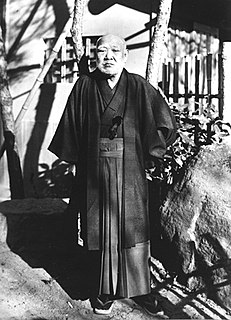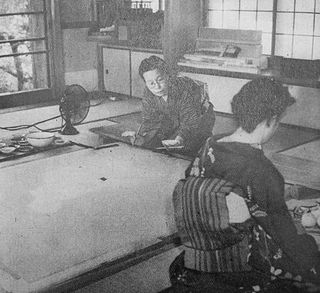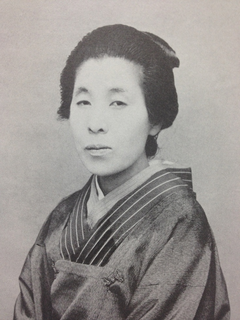 W
WFuku Akino was a Japanese painter. She was born in Futamata, Iwata-gun, Shizuoka Prefecture. She became known by her paintings of Indian themes, landscapes and peoples.
 W
WOtake Chikuha was a Japanese painter. He was first known for his nihonga and ukiyo-e paintings. Although he was a praised figure at the height of his career, he later lost his reputation. He moved onto experimenting with more ambitious styles motivated by his anti-mainstream sentiments.
 W
WJin Goto is a Japanese nihonga and picture book painter.
 W
WHata Teruo was a Japanese painter and graphic artist. In his works, he attempted to synthesize the nihonga and yōga styles. Many of his later works have Buddhist themes.
 W
WGyoshū Hayami was the pseudonym of a Japanese painter in the Nihonga style, active during the Taishō and Shōwa eras. His real name was Eiichi Maita.
 W
WKaii Higashiyama was a Japanese writer and artist particularly renowned for his Nihonga style paintings. As one of the most popular artists in post-war Japan, Higashiyama was awarded the Japan Art Academy Prize in 1956 and the Order of Culture in 1969.
 W
WShodo Hirata (平田松堂) was a Japanese painter who was active from the Meiji era to the Showa era, mainly in public exhibitions. He studied under Kawai Gyokudo and was particularly adept at bird and flower painting.
 W
WIkuo Hirayama, was a Japanese Nihonga painter and educator. Born in Setoda-chō, Hiroshima Prefecture, he was famous in Japan for Silk Road paintings of dreamy desert landscapes in Iran, Iraq, and China.
 W
WHishida Shunsō was the pseudonym of a Japanese painter from the Meiji period. One of Okakura Tenshin's pupils along with Yokoyama Taikan and Shimomura Kanzan, he played a role in the Meiji era innovation of Nihonga. His real name was Hishida Miyoji. He was also known for his numerous paintings of cats.
 W
WHirafuku Hyakusui, originally named Teizō was a Japanese painter in the nihonga style.
 W
WInagaki Chūsei, originally Kōtarō was a Japanese painter in the nihonga style. His younger brother, Inagaki Toshijiro, was a well-known woodcut artist and textile designer who was named a National Treasure.
 W
WIrie Hakō, originally Ikujirō was a Japanese painter in the nihonga style.
 W
WIshibashi Kazunori was a Japanese painter active in both yōga and nihonga. His name can also be read Ishibashi Wakun and he used the art name Gyūgagen.
 W
WShinsui Itō was the pseudonym of a Nihonga painter and ukiyo-e woodblock print artist in Taishō- and Shōwa-period Japan. He was one of the great names of the shin-hanga art movement, which revitalized the traditional art after it began to decline with the advent of photography in the early 20th century. His real name was Itō Hajime.
 W
WKiyokata Kaburaki was the art-name of a Nihonga artist and the leading master of the bijin-ga genre in the Taishō and Shōwa eras. His legal name was Kaburaki Ken'ichi. The artist himself used the reading "Kaburaki", but many Western sources transliterate it as "Kaburagi".
 W
WTamako Kataoka was a Japanese Nihonga painter.
 W
WBokuyō Katayama was a Japanese painter of the nihonga style active in the Shōwa era. Bokuyō claimed Yugen as the keyword of his art, and used traditional materials such as silk, ink and mineral pigments to draw traditional subjects of Japanese art with influence of Western painting.
 W
WKawabata Ryūshi was the pseudonym of a Japanese painter in the Nihonga style, active during the Taishō and Shōwa eras. His real name was Kawabata Shotarō.
 W
WKawai Gyokudō was the pseudonym of a Japanese painter in the nihonga school, active from Meiji through Shōwa period Japan. His real name was Kawai Yoshisaburō.
 W
WKikuchi Keigetsu (菊池契月) was a Japanese Nihonga painter, member of the Japan Art Academy, Imperial Household Artist, and emeritus professor at the Kyoto City University of Arts. In 1922 he travelled to Europe, in particular England, France, and Italy, where he studied the traditions of western art as well as contemporary movements such as Fauvism and Cubism.
 W
WKimura Buzan (木村武山) was a Japanese Nihonga painter associated with the Nihon Bijutsuin.
 W
WRyūsei Kishida was a Japanese painter in Taishō and Shōwa period Japan. He is best known for his realistic yōga-style portraiture, but also for his nihonga paintings in the 1920s.
 W
WChigusa Kitani was a Japanese Nihonga (日本画) painter and painting teacher in Taishō and Shōwa Japan.
 W
WKobayashi Eitaku was a Japanese artist and illustrator specializing in ukiyo-e and nihonga.
 W
WKokei Kobayashi was a Japanese Nihonga painter.
 W
WKobori Tomoto was a Japanese artist. He was an Imperial Household Artist from 1917 until his death in 1931.
 W
WSeison Maeda was the art-name of a nihonga painter in the Taishō and Shōwa periods of Japan. His legal name was Maeda Renzō. He is considered one of the greatest contemporary Japanese painters, and one of the leaders of the Nihonga movement.
 W
WKagaku Murakami was a Japanese painter and illustrator, noted for his numerous Buddhist subjects and advancement in the techniques of nihonga (Japanese-style) painting in the early 20th century.
 W
WGakuryō Nakamura (1890–1969) was a Japanese Nihonga painter and designer.
 W
WYuki Ogura was a Japanese nihonga painter. Her maiden name was Yuki Mizoguchi. She was known for her bijinga.
 W
WTogyū Okumura was a famous Japanese modern painter of the Nihonga style of watercolour painting. His original name was Yoshizō (義三). The name Togyū referred to a poem from his father who ran a publishing business.
 W
WHiroshi Senju is a Japanese Nihonga painter known for his large scale waterfall paintings.
 W
WShima Seien (島成園) (1892–1970) was a nihonga artist in Taishō and Shōwa Japan.
 W
WKanzan Shimomura was the pseudonym of a nihonga painter in Meiji through to the early Shōwa period Japan. His real name was Shimomura Seizaburō.
 W
WYasushi Sugiyama was a Japanese painter of the Shōwa and Heisei eras, who practiced the nihonga style of watercolour painting.
 W
WKomuro Suiun is the pseudonym of a Japanese nihonga painter who worked mainly in the nanga style, active from the Meiji period (1868–1912) to the Shōwa period (1926–1989).
 W
WYumeji Takehisa was a Japanese poet and painter. He is known foremost for his Nihonga illustrations of bijin, beautiful women and girls, though he also produced a wide variety of works including book covers, serial newspaper illustrations, furoshiki, postcards, and patterned washi paper.
 W
WTakeuchi Seihō was a Japanese painter of the nihonga genre, active from the Meiji through the early Shōwa period. One of the founders of nihonga, his works spanned half a century and he was regarded as master of the prewar Kyoto circle of painters. His real name was Takeuchi Tsunekichi.
 W
WTanaka Isson was the pseudonym of a Japanese Nihonga painter from the Shōwa period noted for his flower-and-bird paintings of the Amami Islands. His real name was Tanaka Takashi.
 W
WTomioka Tessai was the pseudonym for a painter and calligrapher in imperial Japan. He is regarded as the last major artist in the Bunjinga tradition and one of the first major artists of the Nihonga style. His real name was Yusuke, which he later changed to Hyakuren.
 W
WTomita Keisen was a Japanese painter in the nihonga style.
 W
WTsuchida Bakusen was the art-name of a Japanese painter in the Nihonga style, active during the Taishō and early Shōwa eras. His birth name was Tsuchida Kinji (土田金二).
 W
WUemura Shōen was the pseudonym of an artist in Meiji, Taishō and early Shōwa period Japanese painting. Her real name was Uemura Tsune. Shōen was known primarily for her bijin-ga, or paintings of beautiful women, in the nihonga style, although she produced numerous works on historical themes and traditional subjects. Shōen is considered a major innovator in the bijin-ga genre despite the fact she often still used it to depict the traditional beauty standards of women. Bijin-ga gained criticism during the Taisho era while Shōen worked due to its lack of evolution to reflect the more modern statuses of women in Japan. During bijin-ga's conception in the Tokugawa, or Edo, period, women were regarded as lower class citizens and the genre often reflected this implication onto its female subjects. Within the Taisho era, women had made several advancements into the Japanese workforce, and artistry specifically was becoming more popular outside of pass times for the elite, which opened way for Shōen's success. Shōen received many awards and forms of recognition during her lifetime within Japan, being the first female recipient of the Order of Culture award, as well as being hired as the Imperial Household's official artist, which had previously only employed one other official woman in the position. In 1949 she died of cancer just a year after receiving the Order of Culture Award.
 W
WYukihiko Yasuda was the pseudonym of a major figure in Taishō and early Shōwa period Japanese painting, and is regarded as one of the founders of the Japanese painting technique of nihonga. His real name was Yasuda Shinzaburō.
 W
WYokoyama Taikan was the art-name of a major figure in pre-World War II Japanese painting. He is notable for helping create the Japanese painting technique of Nihonga.